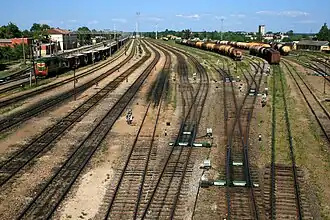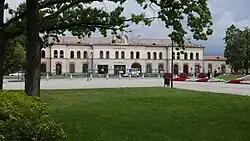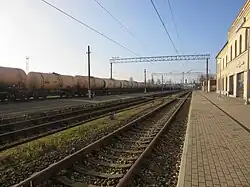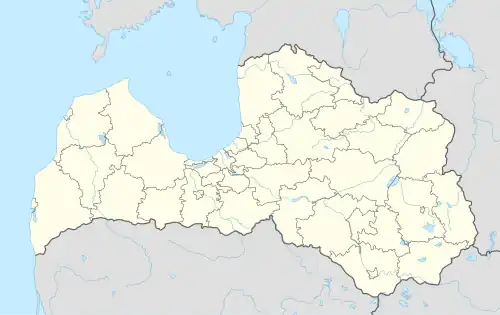Jelgava Station
Jelgava Station | |||||||||||||||||||||||||||||||
|---|---|---|---|---|---|---|---|---|---|---|---|---|---|---|---|---|---|---|---|---|---|---|---|---|---|---|---|---|---|---|---|
.jpg) | |||||||||||||||||||||||||||||||
| General information | |||||||||||||||||||||||||||||||
| Location | Stacijas iela 1 Jelgava[1] Latvia | ||||||||||||||||||||||||||||||
| Coordinates | 56°38′26.11″N 23°43′55.47″E / 56.6405861°N 23.7320750°E | ||||||||||||||||||||||||||||||
| Owned by | Latvijas dzelzceļš (LDz)[2] | ||||||||||||||||||||||||||||||
| Platforms | 3 | ||||||||||||||||||||||||||||||
| Tracks | 27 | ||||||||||||||||||||||||||||||
| Train operators | Vivi[1] LTG Link | ||||||||||||||||||||||||||||||
| Construction | |||||||||||||||||||||||||||||||
| Structure type | At-grade | ||||||||||||||||||||||||||||||
| Architect | Otto Dietze[3] | ||||||||||||||||||||||||||||||
| History | |||||||||||||||||||||||||||||||
| Opened | 1868[4] | ||||||||||||||||||||||||||||||
| Electrified | Yes | ||||||||||||||||||||||||||||||
| Previous names | Mitau | ||||||||||||||||||||||||||||||
| Services | |||||||||||||||||||||||||||||||
| |||||||||||||||||||||||||||||||
| |||||||||||||||||||||||||||||||
Jelgava Station is the main railway station serving the city of Jelgava in the Semigallia region of southern Latvia.[1] The station is located in the central part of the city, on the southeastern edge of the historic town centre, and a short distance west of the Lielupe River.
Jelgava station is an important railway junction where the Riga – Jelgava, Jelgava – Liepāja, Jelgava – Meitene, Tukums II – Jelgava and Jelgava – Krustpils railways all meet.[5] The station is an important rail freight station, which handles around 60 freight trains per day.[6] Passenger trains depart in the direction of Riga.[7]
The station opened in 1868 with the opening of the Riga–Jelgava railway line.[4] The original station building from 1870 designed by the architect Otto Dietze has survived to this day, although it was severely damaged during both world wars.[3][8]
Gallery
-
 Aerial view of the railway station
Aerial view of the railway station -
 View of the railway yard
View of the railway yard -
.jpg) View of the railway yard
View of the railway yard -
 Street facade of the station building
Street facade of the station building -
.jpg) Platform facade of the station building
Platform facade of the station building -
 Platform facade of the station building
Platform facade of the station building -
 Train at Jelgava station
Train at Jelgava station -
 Tracks in the direction of Riga and Krustpils
Tracks in the direction of Riga and Krustpils -
 Tracks in the direction of Liepāja and Tukums
Tracks in the direction of Liepāja and Tukums
See also
References
Citations
- ^ a b c "Vivi". Pasažieru vilciens. Retrieved 7 June 2025.
- ^ "Latvijas dzelzceļš". Latvijas dzelzceļš. Retrieved 7 June 2025.
- ^ a b "Jelgavas novadnieki" (in Latvian). Jelgavas Zinātniskā bibliotēka. Archived from the original on 2011-07-22. Retrieved 2009-03-12.
- ^ a b "Latvijas dzelzceļu līnijas" (in Latvian). Latvian Railway History Museum. Archived from the original on 29 March 2014. Retrieved 10 October 2010.
- ^ "Publiskās lietošanas dzelzceļa infrastruktūras pārskats 2011" [2011 Public Railway Infrastructure Overview] (PDF) (in Latvian). Latvian Railways. 2010-06-05. p. 36. Archived from the original (PDF) on 2011-04-09. Retrieved 2010-10-10.
- ^ Stokenberga, Daiga. "Jelgava — viens no nozīmīgākajiem dzelzceļa mezgliem" [Jelgava – one of the most important railway hubs] (in Latvian). Neatkarīgā Rīta Avīze. Archived from the original on 5 May 2010. Retrieved 6 March 2011.
- ^ https://www.pv.lv/images/userfiles/Vivi_Riga_Pienaksana_10.12.2023..pdf
- ^ Altbergs, Augustāne & Pētersone 2009, p. 45.
Bibliography
- Altbergs, T.; Augustāne, K.; Pētersone, I. (2009). Dzelzceļi Latvijā [Railways in Latvia] (in Latvian). Jumava. ISBN 978-9984-38-698-0.
External links
- (in Latvian and English) Latvijas dzelzceļš (LDz) – state-owned railway infrastructure manager in Latvia.
- (in Latvian and English) Pasažieru vilciens (Vivi) – state-owned passenger train operating company in Latvia.
